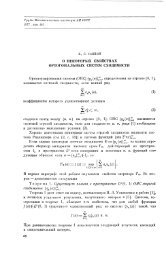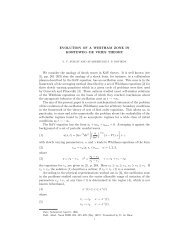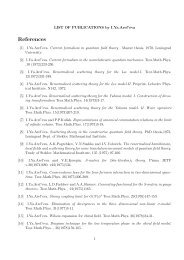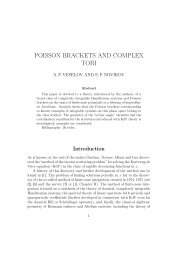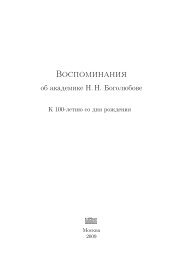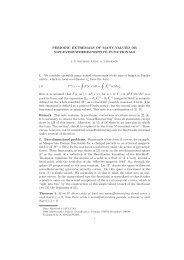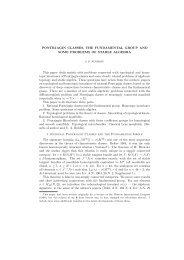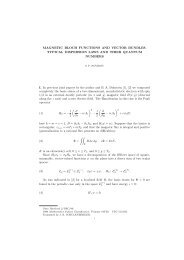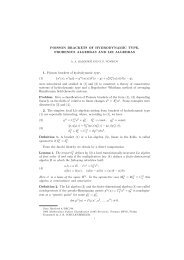A periodic problem for the Korteweg-de Vries equations, I.
A periodic problem for the Korteweg-de Vries equations, I.
A periodic problem for the Korteweg-de Vries equations, I.
You also want an ePaper? Increase the reach of your titles
YUMPU automatically turns print PDFs into web optimized ePapers that Google loves.
10 S. P. NOVIKOV1) The Case n = 1. In this case we have <strong>the</strong> equationcu ′ + 6uu ′ − u ′′′ = 0,)u ′′ = 3u 2 + cu + d, u ′2 = 2(u 3 + cu22 + du + E .We obtain <strong>the</strong> elliptic function∫x =du√2u3 + cu 2 + 2du + 2E ,where u(x − ct) is a solution of <strong>the</strong> KV equation of <strong>the</strong> type of a simple wave.According to Theorem 2.1 u(x) is a 1-zone potential. This fact was first provedby E. Ince in 1940 in ano<strong>the</strong>r language and by ano<strong>the</strong>r method [14]; <strong>the</strong> Sturm–Liouville equation with an elliptic potential is a special case of <strong>the</strong> Lamé equationarising from <strong>the</strong> Laplace operator on an ellipsoid where 1/2 n(n + 1)-fold ellipticfunctions also occur in <strong>the</strong> potential. (As shown in [14], <strong>the</strong>y are n-zone potentialswhich are a <strong>de</strong>generate case of <strong>the</strong> general n-zone potentials given by Theorem 2.1).In <strong>the</strong> basis ψ k , ¯ψ k <strong>the</strong> matrix Λ has <strong>the</strong> <strong>for</strong>mλ = ik2k 2 (u′′ − 2u 2 + 8k 2 ) − ick + icu2k ,µ = −u ′ + ik2k 2 (−u′′ + 2u 2 + 4k 2 u) − icu(17)2k ,and <strong>the</strong> characteristic polynomial has <strong>the</strong> <strong>for</strong>m<strong>de</strong>t Λ = 4k 6 + 2ck 4 + c2 + 4dk 2 +4cd − 2E. (17 ′ )4We see that k1 2 + k2 2 + k3 2 = −c/2. If <strong>the</strong> period T → ∞ and u(x) tends to a rapidly<strong>de</strong>creasing function, <strong>the</strong>n E → 0, d → 0. There<strong>for</strong>e, k 3 → 0, k1 2 → −κ 2 , k2 2 → −κ 2 ,and <strong>the</strong> zone contracts to <strong>the</strong> eigenvalue k 2 = −κ 2 where κ 2 = c/4.We note that <strong>the</strong> transcen<strong>de</strong>ntal equation <strong>for</strong> all <strong>the</strong> <strong>de</strong>generate points of <strong>the</strong>spectrum follows from Remark 1.2) The Case n = 2. On <strong>the</strong> basis of Remark 3 we consi<strong>de</strong>r only an equation of<strong>the</strong> <strong>for</strong>m(d δIndx δu(x) + 8c δI )0= 0, (8 ′′ )δu(x)where 8I 0 = ∫ (8u 2 ) dx, I 2 = ∫ ( )u ′′22 − 5 2 u2 u ′′ + 5 2 u4 dx [we obtain all 2-zone potentialsby adding a constant to <strong>the</strong> solutions of Eq. (8 ′′ )]. The Lagrangian of <strong>the</strong>dynamical system (8 ′′ ) has <strong>the</strong> <strong>for</strong>mL = L 2 + 8cL 0 − du = L(u, u ′′ ), 8L 0 = 8u 2 , L 2 = u′′22 − 5 2 u2 u ′′ + 5 2 u4 .We <strong>de</strong>note by q <strong>the</strong> quantity q = (∂L/∂u ′′ ). The energy of a system in which <strong>the</strong>Lagrangian <strong>de</strong>pends on two <strong>de</strong>rivatives has <strong>the</strong> <strong>for</strong>mE = L − u ′′ q + u ′ q ′ .We <strong>de</strong>note u ′ by p q and q ′ by p u . Then E = H(u, q, p u , p q ) = V (u, q) + p u p q , andEqs. (8 ′′ ) assumes <strong>the</strong> Hamiltonian <strong>for</strong>mp ′ u = − ∂H∂u ,p′ q = − ∂H∂q ,u′ = ∂H∂p ,q′ = ∂H∂p q,



